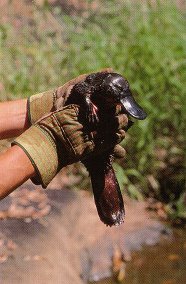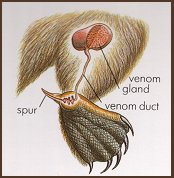THE ORDER MONOTREMATA
Table of Contents
Monotremata – One Holed Mammals – Three species.
There are only three living species of monotremes in the world: the duck-billed platypus, the long-beaked echidna, and the short-beaked echidna. The platypus is found only in the eastern states of Australia, and is such an unusual animal that when the first specimen was sent back to Britain in 1798 it was widely assumed to be a fake, made by stitching together the beak of a duck and the body parts of a mammal! Both species of echidna, also known as the spiny anteater, are found on the island of New Guinea, but only the short-beaked echidna is also widely distributed in Australia.

These are the most primitive of the living mammals, retaining some characteristics of their reptilian ancestors and displaying some characteristics of birds as well. The order name Monotremata means “one hole,” and refers to the fact that all three species have only one opening to the outside of their bodies through which the products of the reproductive (eggs) and excretory (feces and urine) systems are passed. This feature is not exclusive to the monotremes, since marsupials also have this arrangement, but monotremes lay eggs instead of giving birth to live young as all other mammals do. The eggs are soft-shelled and measure approximately 2/3 inches across. They are incubated for about 10 days, after which the hatchlings are fed milk from mammary glands, and thus they tie to “mammals.”
Monotremes
While the monotremes have some anatomical similarities to reptiles, the fact that they suckle their young, possess hair, have a single bone making up each side of the lower jaw, and have a muscular diaphragm for breathing, is enough evidence for biologists to place them in the mammalian class. The more you learn about animals, however, the more you realize that for every rule, there is an exception.
Their body temperature is also subject to considerable fluctuation. Thus the monotremes are living links between reptiles and mammals. They are not, however, the ancestors of more advanced mammals, but rather an early offshoot that developed along variant lines in long isolation.
Platypus
 The platypus is one of the very few venomous mammals. Rear-ankle spurs are found in all three species of male monotremes, while the females lose the spur during the first year of life. Although the spurs and glands persist in male echidnas, they do not seem to use the system to inject venom. Fully grown adult spurs are around 1/2 inch in length and can be pointed away from the ankles for use as weapons. The puncture alone is painful, but the venom injected can lead to symptoms ranging from local pain and swelling to paralysis of a whole limb in humans. The spurs certainly represent a deterrent to predators, but their loss in females suggests that this is not their primary function. However, the exact reason for the poisonous spurs in the male platypus remains a mystery even today.
The platypus is one of the very few venomous mammals. Rear-ankle spurs are found in all three species of male monotremes, while the females lose the spur during the first year of life. Although the spurs and glands persist in male echidnas, they do not seem to use the system to inject venom. Fully grown adult spurs are around 1/2 inch in length and can be pointed away from the ankles for use as weapons. The puncture alone is painful, but the venom injected can lead to symptoms ranging from local pain and swelling to paralysis of a whole limb in humans. The spurs certainly represent a deterrent to predators, but their loss in females suggests that this is not their primary function. However, the exact reason for the poisonous spurs in the male platypus remains a mystery even today.
The fossil record is very scant. So distinctive are the monotremes from any other orders of mammals that the Monotremata have a separate subclass, Prototheria – Earliest Mammals. The order is divided into two families: the Tachyglossidae, which has two members-the Australian spiny anteaters and the giant echidna of New Guinea; and the Ornithorhynchidae, which has but one – the platypus.
